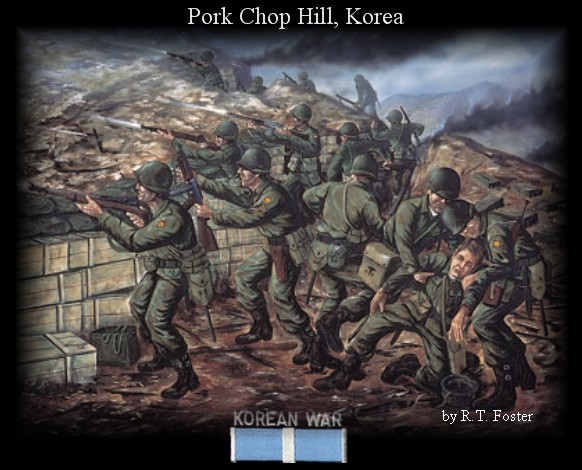|


All 82nd & D Company
237th Engineer members that served in Korea, please sign the Korea Vets Book below. Please provide the information requested.
Sign Korea Vet's Book View Korea Vet's Book






June 25, 1950
At approximately 4 a.m. (Korean Standard Time) on a rainy Sunday
morning Democratic People's Republic of Korea Army (DPRK - North Korea) artillery and mortars open fire on Republic of Korea
(ROK - South Korea) Army positions south of the 38th Parallel, the line then serving as the border between the
two countries. The opening barrage is followed shortly by tank/infantry attacks at all points along the Parallel. At 11 a.m.
North Korea announced a formal declaration of war and what is now known as "The Korean War" officially began. In this announcement
North Korea claimed ROK forces on the Ongjin Peninsula attacked North Korea in the Haeju area (west) and their declaration
of war was in response to this attack. This claim was bogus.
U.S. President Harry S. Truman was notified of the invasion and
returned from his home in Independence, Missouri, to Washington, D.C., arriving in early afternoon. Meanwhile the U.N. Security
Council passed a resolution calling for the immediate cessation of hostilities and the withdrawal of North Korean forces to
north of the 38th Parallel.
June 27, 1950
During the late evening, the U.N. Security council passes a resolution
calling for member nations to give military aid to South Korea.
Meanwhile, in compliance with President Truman's order to provide
help to South Korea and the use of U.S. air and naval forces south of the 38th Parallel, General MacArthur sent
a fact finding group, headed by Brig. General Church, to Korea. This group left Japan at approximately 4 a.m. and arriving
at Suwon in the early afternoon where they set up a temporary headquarters.
A U.S. Air Force F-82 shoots down a North Korean Yak fighter for
the first U.S. air victory of the war. Two more North Korean aircraft are shot down a few minutes later in this same battle.
July 27 1953
Last air kill of the
war. F-86 pilot downs an enemy transport near the Manchurian border.
July 27 1953
The United States, North
Korea and China sign an armistice, which ends the war but fails to bring about a permanent peace. To date, the Republic of
Korea (South) and Democratic Peoples' Republic of Korea (North) have not signed a peace treaty. North and South Korea did
sign a non-aggression treaty in 1991.
A total of 29,557 service members (all services) died in battle,
or from battle-related injuries, during the Korean War. 4184 died from non-combat causes in the Korean theater. 92,934 were
wounded in action seriously enough to be evacuated. (This number does not include those lightly wounded who were treated at
battalion/regimental aid stations and returned to duty.) 7,245 service members became Prisoners-of-War.
TROOP STRENGTHS
- Peak strength for the UNC was 932,964 on July 27, 1953 -- the day
the Armistice Agreement was signed:
- Republic of Korea 590,911
- Columbia 1,068
- United States 302,483
- Belgium 900
- United Kingdom 14,198
- South Africa 826
- Canada 6,146
- The Netherlands 819
- Turkey 5,453
- Luxembourg 44
- Australia 2,282
- Philippines 1,496
- New Zealand 1,385
- Thailand 1,204
- Ethiopia 1,271
- Greece 1,263
- France 1,119
Click below THE KOREAN WAR
to view LINK about the Korean War

|

